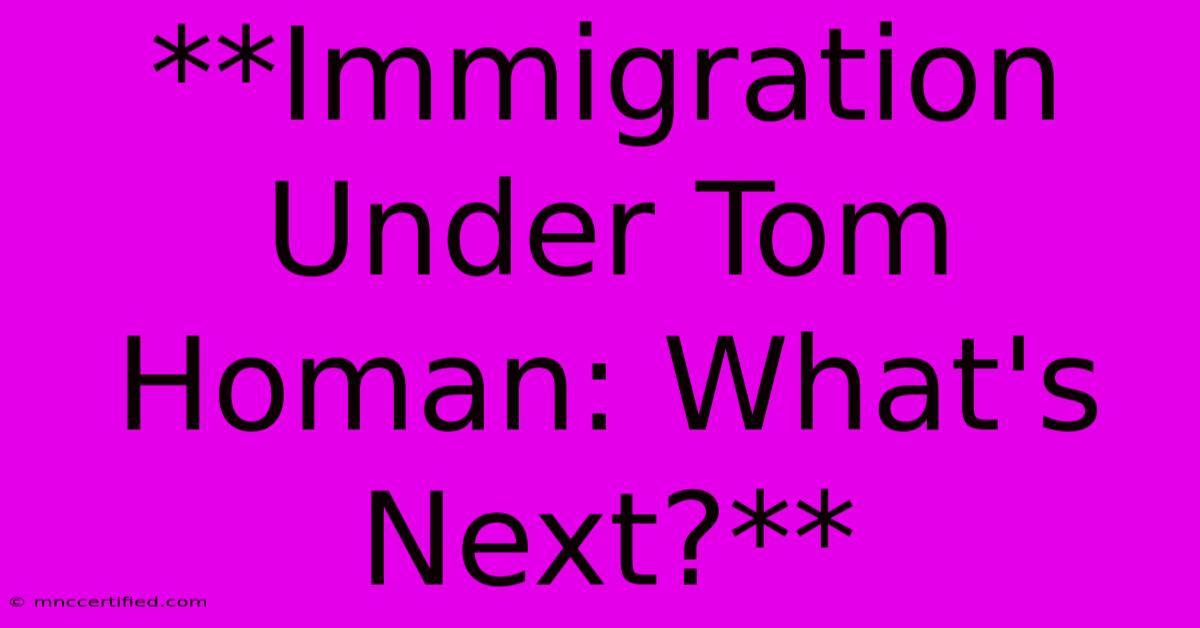**Immigration Under Tom Homan: What's Next?**

Table of Contents
Immigration Under Tom Homan: What's Next?
Tom Homan, a familiar face in the world of immigration enforcement, served as the Acting Director of U.S. Immigration and Customs Enforcement (ICE) from January 2017 to April 2018, during a period marked by heightened scrutiny and debate over immigration policy. His legacy continues to influence the direction of immigration enforcement, prompting the question: what's next for immigration under the shadow of Tom Homan's tenure?
Homan's Legacy: A Focus on Enforcement
Homan's approach to immigration enforcement was characterized by a zero-tolerance policy, a focus on deportations, and a strong stance against sanctuary cities. His tenure saw an increase in ICE raids and detention capacity, as well as the separation of families at the border. This "tough on immigration" approach resonated with the Trump administration's policies, solidifying Homan's position as a key figure in the implementation of these measures.
Key aspects of Homan's approach included:
- Increased Enforcement: ICE raids and deportations saw a notable rise, particularly targeting undocumented immigrants with criminal records.
- Zero Tolerance Policy: This policy resulted in the prosecution of all individuals who illegally crossed the border, including families, leading to family separations.
- Sanctuary City Crackdown: Homan spearheaded efforts to pressure and penalize sanctuary cities that limit cooperation with ICE.
The Impact of Homan's Policies
Homan's policies ignited widespread debate, raising concerns about human rights violations, family separation, and the overall impact on immigrant communities. Critics argued that his approach was inhumane and ineffective, while supporters maintained its necessity for border security and deterrence.
The impact of Homan's policies continues to be felt today. The separation of families remains a highly contested issue, with lasting consequences for those affected. Furthermore, the expansion of detention facilities and the increased use of detention have drawn criticism for their impact on immigrant well-being.
The Future of Immigration Enforcement
With Homan no longer in the spotlight, the future of immigration enforcement remains uncertain. While the Biden administration has implemented a less aggressive approach, including reversing the zero-tolerance policy and limiting the use of detention, the fundamental challenges of immigration remain.
Key factors to consider for the future of immigration enforcement include:
- Political Polarization: The issue of immigration remains deeply divided, with both sides holding strong opinions.
- Economic Impact: The economic contributions of immigrants, both documented and undocumented, will continue to be a key factor in policy discussions.
- International Cooperation: Addressing the root causes of migration and fostering collaboration with other countries will be crucial.
The future of immigration will depend on a nuanced approach that balances security concerns with the rights and needs of individuals. The legacy of Tom Homan will continue to inform the debate, but ultimately, the path forward will be shaped by evolving political realities, social values, and the complexities of a globalized world.
SEO Keywords:
- Immigration Enforcement
- Tom Homan
- ICE
- Zero Tolerance Policy
- Deportation
- Sanctuary Cities
- Family Separation
- Detention
- Immigration Policy
- Biden Administration
- Political Polarization
- Economic Impact
- International Cooperation

Thank you for visiting our website wich cover about **Immigration Under Tom Homan: What's Next?**. We hope the information provided has been useful to you. Feel free to contact us if you have any questions or need further assistance. See you next time and dont miss to bookmark.
Featured Posts
-
Dental Bonding Front Teeth Gap Cost
Nov 12, 2024
-
Trump Nominates Stefanik For Un Ambassador
Nov 12, 2024
-
Arizona Talent Making The Ciutat Esportiva
Nov 12, 2024
-
Lawyers Who Sue Insurance Companies
Nov 12, 2024
-
Trump Names Stefanik Un Ambassador
Nov 12, 2024